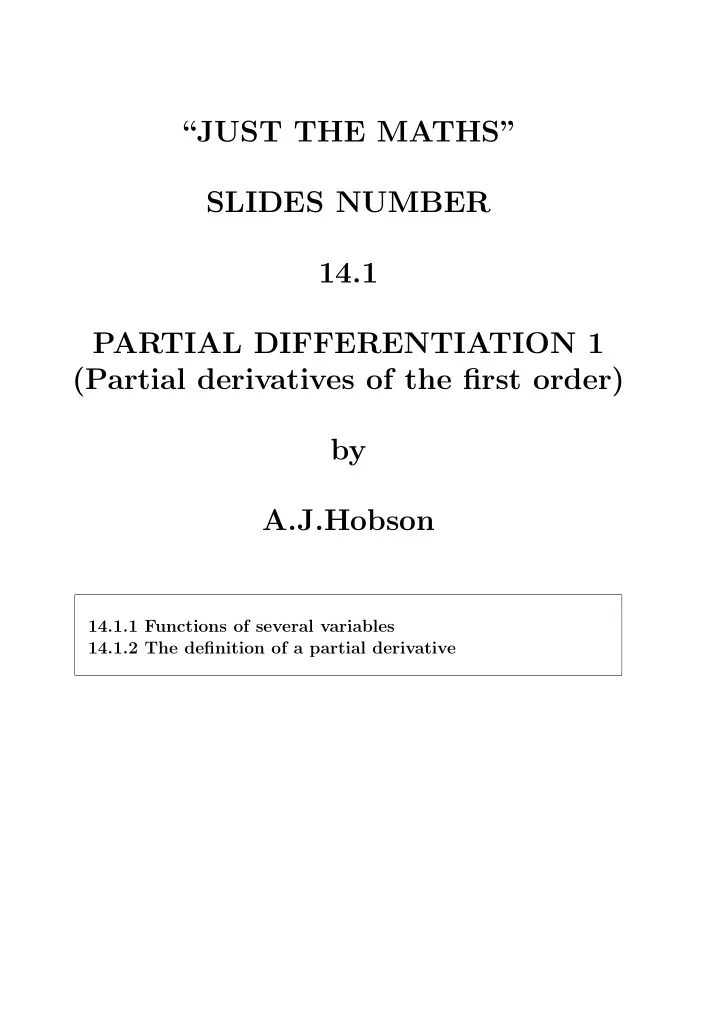

“JUST THE MATHS” SLIDES NUMBER 14.1 PARTIAL DIFFERENTIATION 1 (Partial derivatives of the first order) by A.J.Hobson 14.1.1 Functions of several variables 14.1.2 The definition of a partial derivative
UNIT 14.1 PARTIAL DIFFERENTIATION 1 PARTIAL DERIVATIVES OF THE FIRST ORDER 14.1.1 FUNCTIONS OF SEVERAL VARIABLES In most scientific problems, it is likely that a variable quantity under investigation will depend (for its values), not only on one other variable quantity, but on several other variable quantities. The type of notation used may be indicated by examples such as the following: 1. z = f ( x, y ) . 2. w = F ( x, y, z ) . Normally, the variables on the right-hand side are called the “independent variables” . The variable on the left-hand side is called the “dependent variable” . 1
Notes: (i) Some relationships between several variables are not stated as an explicit formula for one of the variables in terms of the others. ILLUSTRATION x 2 + y 2 + z 2 = 16 . In such cases, it may be necessary to specify separately which is the dependent variable. (ii) The variables on the right-hand side of an explicit formula, may not always be independent of one another ILLUSTRATION In the formula z = xy 2 + sin( x − y ) , suppose that x = t − 1 and y = 3 t + 2; Then the variables, x and y , are not independent of each other. In fact, y = 3( x + 1) + 2 = 3 x + 5. 2
14.1.2 THE DEFINITION OF A PARTIAL DERIVATIVE ILLUSTRATION r h The volume, V , and the surface area, S , of a solid right- circular cylinder with radius r and height h are given by V = πr 2 h and S = 2 πr 2 + 2 πrh. V and S are functions of r and h . Suppose r is held constant while h is allowed to vary. Then, d V r const . = πr 2 d h and d S r const . = 2 πr. d h 3
These are the “partial derivatives of V and S with respect to h ” . Similarly, suppose h is held constant while r is allowed to vary. Then, d V h const . = 2 πrh d r and d S h const . = 4 πr + 2 πh. d r These are the “partial derivatives of V and S with respect to r ” . THE NOTATION FOR PARTIAL DERIVATIVES This is indicated by ∂V ∂S ∂h = πr 2 , ∂h = 2 πr and ∂V ∂S ∂r = 2 πrh, ∂r = 4 πr + 2 πh. 4
EXAMPLES 1. Determine the partial derivatives of the following func- tions with respect to each of the independent variables: (a) z = ( x 2 + 3 y ) 5 . Solution ∂z ∂x = 5( x 2 + 3 y ) 4 . 2 x = 10 x ( x 2 + 3 y ) 4 and ∂z ∂y = 5( x 2 + 3 y ) 4 . 3 = 15( x 2 + 3 y ) 4 . (b) w = ze 3 x − 7 y . Solution ∂w ∂x = 3 ze 3 x − 7 y , ∂w ∂y = − 7 ze 3 x − 7 y , and ∂w ∂z = e 3 x − 7 y . 5
(c) z = x sin(2 x 2 + 5 y ) . Solution ∂z ∂x = sin(2 x 2 + 5 y ) + 4 x 2 cos(2 x 2 + 5 y ) and ∂z ∂y = 5 x cos(2 x 2 + 5 y ) . 2. If z = f ( x 2 + y 2 ) , show that x∂z ∂y − y∂z ∂x = 0 . Solution ∂z ∂x = 2 xf ′ ( x 2 + y 2 ) and ∂z ∂y = 2 yf ′ ( x 2 + y 2 ) . Hence, x∂z ∂y − y∂z ∂x = 0 . 6
3. If cos( x + 2 z ) + 3 y 2 + 2 xyz = 0 (where z is the dependent variable), determine expres- sions for ∂z ∂x and ∂z ∂y in terms of x , y and z . Solution 1 + 2 ∂z x∂z + 2 y = 0 − sin( x + 2 z ) . ∂x + y ∂x and − sin( x + 2 z ) . 2 ∂z y∂z ∂y + 6 y + 2 x ∂y + z = 0 , respectively. Thus, ∂x = sin( x + 2 z ) − 2 y 2 ∂z 2 yx − 2 sin( x + 2 z ) and ∂z 2 xz + 6 y xz + 3 y ∂y = 2 sin( x + 2 z ) − 2 xy = sin( x + 2 z ) − xy. 7
Recommend
More recommend